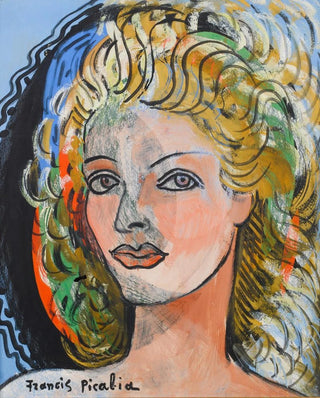Painting Aux blondes - Francis Picabia | Art print


View from behind

Frame (optional)
The artwork "Aux blondes" by Francis Picabia is an iconic piece that embodies the avant-garde spirit of the early 20th century. This painting, rich in colors and emotions, immerses us in a universe where modernity blends with classical influences. With its bold approach and intriguing composition, Picabia manages to capture the essence of a rapidly changing era. The artist, through this work, invites us to reflect on notions of beauty and desire, while highlighting the social dynamics that prevailed at the time. The art print Aux blondes - Francis Picabia allows you to appreciate this artistic richness in the comfort of your home, while offering a window into the history of modern art.
Style and uniqueness of the work
The style of "Aux blondes" stands out through a daring use of colors and shapes. Picabia, a true master of composition, plays with contrasts to create an atmosphere that is both vibrant and enigmatic. The female figures, depicted with palpable sensuality, seem to move within a space that is both real and imaginary. The artist blends influences of cubism and dadaism, making his work both accessible and deeply complex. Every brushstroke seems to tell a story, an emotion, a thought. The texture of the paint invites the viewer to get closer, to scrutinize the details, to discover the subtleties that make this work a true masterpiece. The light, omnipresent, plays a fundamental role, emphasizing the forms and creating a dialogue between the characters and their environment.
The artist and his influence
Francis Picabia is an essential figure in the world of modern art, an artist whose career is marked by a constant search for new forms of expression. Born in 1879 in Paris, he evolves through various artistic movements, from Fauvism to Dadaism, passing through cubism. His work reflects a troubled era, where conventions are questioned. Picabia does not merely follow trends; he creates them. His influence extends far beyond his own artistic production, inspiring many contemporary and future artists.

Matte finish

View from behind

Frame (optional)
The artwork "Aux blondes" by Francis Picabia is an iconic piece that embodies the avant-garde spirit of the early 20th century. This painting, rich in colors and emotions, immerses us in a universe where modernity blends with classical influences. With its bold approach and intriguing composition, Picabia manages to capture the essence of a rapidly changing era. The artist, through this work, invites us to reflect on notions of beauty and desire, while highlighting the social dynamics that prevailed at the time. The art print Aux blondes - Francis Picabia allows you to appreciate this artistic richness in the comfort of your home, while offering a window into the history of modern art.
Style and uniqueness of the work
The style of "Aux blondes" stands out through a daring use of colors and shapes. Picabia, a true master of composition, plays with contrasts to create an atmosphere that is both vibrant and enigmatic. The female figures, depicted with palpable sensuality, seem to move within a space that is both real and imaginary. The artist blends influences of cubism and dadaism, making his work both accessible and deeply complex. Every brushstroke seems to tell a story, an emotion, a thought. The texture of the paint invites the viewer to get closer, to scrutinize the details, to discover the subtleties that make this work a true masterpiece. The light, omnipresent, plays a fundamental role, emphasizing the forms and creating a dialogue between the characters and their environment.
The artist and his influence
Francis Picabia is an essential figure in the world of modern art, an artist whose career is marked by a constant search for new forms of expression. Born in 1879 in Paris, he evolves through various artistic movements, from Fauvism to Dadaism, passing through cubism. His work reflects a troubled era, where conventions are questioned. Picabia does not merely follow trends; he creates them. His influence extends far beyond his own artistic production, inspiring many contemporary and future artists.
12,34 €






